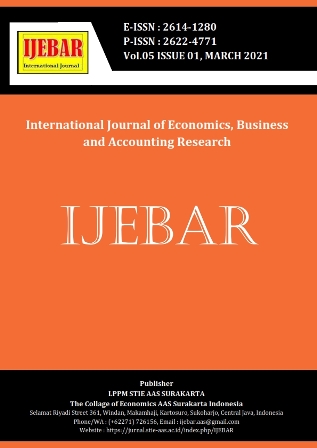The Effectiveness of Succession in a Family Business: Case Study on Batik Industry in Indonesia
DOI:
https://doi.org/10.29040/ijebar.v5i1.2092Abstract
References
———. 1992. Succession experience of the next generation. Family Business Review 5 (3):283-307.
Adedayo, O. S., O. J. Olanipekun, and O. Ojo. 2016. Planning for succession and firm’s sustainability: Evidence from family owned businesses in Lagos and Ogun States, Nigeria. Issues in Business Management and Economics 14 (6):63-69.
Ahrens, J.-P., A. Landmann, and M. Woywode. 2015. Gender preferences in the CEO successions of family firms: Family characteristics and human capital of the successor. Journal of Family Business Strategy 6:86-103.
Aronoff, C. E., S. McClure, and J. Ward. 2011. Business Succession: The Final Test of Greatness. 2nd ed. USA: Palgrave Macmillan.
Barach, J., and J. Gantisky. 1995. Successful succession in family business. Family Business Review 8 (2):131-155.
Baur, M. 2014. Successors and the Family Business: Novel Propositions and a New Guiding Model for Effective Succession. The Journal of American Academy of Business 19 (2):133-138.
Beckhard, R., and G. Dyer. 1983. Managing continuity in the family-owned business. Organizational Dynamics 12 (1):5-12.
Boyd, B., S. Royer, R. Pei, and X. Zhang. 2015. Knowledge transfer in family business successions: Implications of knowledge types and transaction atmospheres. Journal of Family Business Management 5 (1):17-37.
Carlock, R., and J. L. Ward. 2001. Strategic Planning For The Family Business: Parallel Planning To Unify The Family And Business. New York: Palgrave Macmillan.
Carsrud, A. L. 1994. Meanderings of a resurrected psychologist, or lessons learned in creating a family business program. Entrepreneurship Theory and Practice 19 (1):39-48.
Chirico, F. 2007. The accumulation process of knowledge in family firms. Electronic Journal of Family Business Studies 1 (1):62-90.
Chrisman, J. J., P. Sharma, and T. R. Yoder. 2009. Guiding family business through the succession process: a step by step guide for CPA advisors. The CPA Journal:48-51.
Danco, L. 1982. Beyond Survival: A Guide for The Business Owner and His Family. Cleveland, OH: University Press.
European Family Businesses. Definition of Famil Business 2016 [cited. Available from http://www.europeanfamilybusinesses.eu/family-businesses/definition.
Fenn, D. 1994. Are your kids good enough to run your business. INC, 36-48.
Ghee, W. Y., M. D. B. Ibrahim, and H. Abdul-Halim. 2015. Family business succession planning: Unleashing the key factors of business performance. Asian Academy of Management Journal 20 (2):103-126.
Handler, W. 1990. Succession in family firms: a mutual role adjustment between entrepreneur and next-generation family members. Entrepreneurship Theory and Practice 15 (Auntumn):37-51.
Handler, W. C. 1989. Methodological Issues And Consideration In Studying Family Business. Family Business Review 2 (3):257-276.
Khorlina, M. M., and R. H. Mustamu. 2015. Analisis Proses Perencanaan Suksesi Pada Perusahaan Yang Bergerak Di Bidang Transportasi. Agora 3 (1):716-724.
Lumintan, S. R., and R. H. Mustamu. 2015. Analisis Proses Suksesi Pada Perusahaan Produk Kecantikan. Agora 1 (1):97-104.
Mandl, I. 2004. Business Transfers and Succession in Austria. In ISBE Research and Policy Conference. Teesside University.
Miller, D., L. Steier, and I. Breton-Miller. 2003. Lost in time: intergenerational succession, change, and failure in family business. Journal of Business Venturing 18 (4):513-531.
Miller, M., I. Le Breton-Miller, and B. Scholnick. 2008. Stewaardship and stagnation: An Empirical comparison of family and non-family business. Journal of Management Studies 45 (1):51-78.
Morris, M. H., R. W. William, and D. Nel. 1996. Factors influencing family business succession. International Journal of Entrepreneurial Behaviour & Research 2 (3):68-81.
Poza, E. J. 2010. Family Business. 3rd ed. USA: Cangage Learning Academic.
Rothwell, W. J. 2001. Effective succession planning: Leadership continuity and building talent from within. New York: American Management Association.
Sales, M. J. 1990. Succession planning in the family business. Small Business Reports 15 (2):31.
Sharma, P., J. J. Chrisman, A. L. Pablo, and J. H. Chua. 2001. Determinants of initial satisfaction with the succession process in family firms: a conceptual model. Entrepreneurship Theory and Practice 25 (3):17-35.
Singhry, H. B. 2010. An examination of management succession on the sustainability of family businesses in Nigeria: Problems and alternative solutions. In 2nd Annual International Conference on Business and Public Policy, 77-89.
Susanto, A. B. 2007. Corporate social responsibility. Jakarta: The Jakarta Consulting Group.
Tirdasari, N. L., and W. Dhewanto. 2012. Family business succession in Indonesia: A Study of Hospitality Industry. Procedia-Social and Behavioral Sciences 57:69-74.
Ward, J. L. 2011. Keeping the Family Business Healthy: How to Plan for Continuing Growth, Profitability, and Family Leadership. New York: Palgrave Macmilalan.





